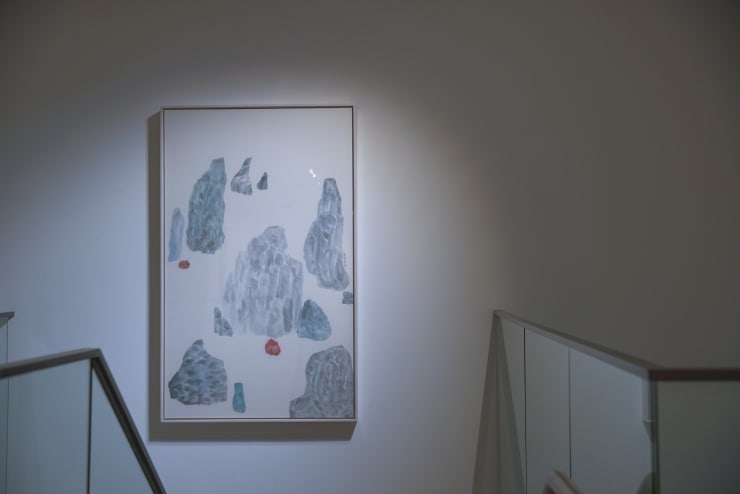Moist and Burnt: As Ink Breathes: Yuan Hui-Li Solo Exhibition
When nature’s tranquility is replaced by the aridness of industrial society, how does the artist respond via the medium of ink to the environment radically altered by climate change?
Contemporary ink painter Yuan Hui-Li, ideologically inclined by her perception of tradition, history, and context, has long been on the path to innovation. Her second solo exhibition at the Tina Keng Gallery, Moist and Burnt: As Ink Breathescontinues the artist’s exploration of ink and possibilities of modernity within this medium, as she draws parallels between the condition of air and the two physical properties of ink. Classical painting theories emphasize the vivacious expression of swirling clouds of mist in ink. This principle gave rise to the “moistness” in literati painters’ use of the medium, which has prevailed for centuries. The traditional view of moistness in ink, when confronted with the scorchedness in the air induced by modern-day industrialization, appears to be antiquated. Out of these circumstances was born “Fiery Ink,” Yuan’s original series where she juxtaposes the “burntness” of smog and the “moistness” of ink, bridging the gap between traditional and contemporary contexts for this age-old medium.
“Fiery Ink” was inspired by the artist’s trip to Beijing in the winter of 2015, where a red alert for severe smog prompted her physical and psychological shock. It was then that the artist first realized the ancient land that had cradled millennia of history became a far cry from the unworldly utopia portrayed in literati painting, and that the traditional language of ink no longer corresponded with reality. Determined to innovate the timeworn medium, the artist rendered the work of classical shanshuipainters in ashes of burnt Chinese handmade paper, and in so doing, shifted the context for traditional landscape painting. Her creative twist on the medium’s physicality serves not only as a reactionary response to the disquieting phenomenon of global warming, but also helps change the trajectory of traditional ink aesthetics. In addition to paintings, Yuan will present a performance/installation piece from the“Fiery Ink” series where she conducts a ritualistic performance that brings forth an installation in the form of worship, as a metaphor for the modern-day survivor surrounded by the remains of what was once transcendental, lamenting the bygone shanshuiand the unrelenting passage of time.
Contrasted with “Fiery Ink,” the artist’s classical ink series “Discrete Islands” and “More Is Less” embody the moistness of the medium awash in luminance and ethereality. The blocks in the “Discrete Islands” series instantiate the artist’s life in Jinshan, Taiwan, a rural area on the coast known for its mountains and view of the sea, as well as its air of misty evanescence. They also illustrate the geographical and political isolation of Taiwan. The artist captures the sense of respiration in the misty humid climate, as well as the vast expanse of void, accentuating the subtle variations in the materiality of ink through different textures and techniques. The “More Is Less” series elicits the physicality of the cicada wing xuanpaper in the artist’s layering of ink. Shaded, textured, and colored, thousands of dots and brushstrokes coalesce into an accumulation of ink, revealing a sense of interiority in a crystalline constellation. The form and rhythm of ink is conveyed in the two series in the rendering of the likeness and otherness of mountain and rock, in the manifestation of the mountain in its noneness, in the contemplative observation of figuration and abstraction portrayed in simplified or sophisticated brushstrokes. Through an interplay of water and ink, she reimagines natural terrain in metaphorical terms and aesthetics of materiality.
Informed by the artist’s knowledge of ancient art history and contemporary practice, as well as her distinct experience of two forms of respiration, the exhibition is a dialectical response to humanity’s status quo which draws a contrast between mist and smog, moistness and burntness, traditional ink and fiery ink. The transformable physicality of ink echoes her observation and reflection on the changing environment and its impact on human existence. Juxtaposing the natural elements of water and fire, the artist proposes a dialectic between two kinds of ink aesthetics in an examination of the human respiration. To reinterpret classical Chinese painting in fiery ink, just as famed curator Xia Ke-Jun once said, “is a restructuring of traditional ink painting after its withering,” and “an authentic expression of modern aesthetics.”
Yuan Hui-Li
Born in 1963 in Taipei, Taiwan, Yuan Hui-Li is also known as Yuan Shu. She received a bachelor’s degree from the first Chinese ink paintingprogram of the National Institute of the Arts (now TNUA) in 1987, a master’s degree in ink painting from the Taipei National University of the Arts in 2005, and a doctoral degree in art creation and theory from the Tainan National University of the Artsin 2016. She was a lecturer at the department of arts and design at the National Hsinchu University, and the department of architecture at the Tamkang University. Her work is housed in the collection of several international institutions, including the UBS (Union Bank of Switzerland), London, UK; Kaohsiung Museum of Fine Arts, Kaohsiung, Taiwan; National Taiwan Museum of Fine Arts, Taichung, Taiwan; Kuandu Museum of Fine Arts, Taipei, Taiwan; Juming Museum, New Taipei City, Taiwan; and Han House Museum, Hangzhou, China. Notable exhibitions include Reading the Landscape: Stories from Artists, Kaohsiung Museum of Fine Arts, Kaohsiung, Taiwan (2016); A Place of One’s Own: Juming Museum Collection, Juming Museum, New Taipei City, Taiwan (2016); Reshaping Tradition, China Central Academy of Fine Arts, Beijing, China (2015);Plural Landscape: Yuan Hui-Li Solo Exhibition, Tina Keng Gallery, Taipei, Taiwan (2014); and Element.Rhythm: Yuan Hui-Li Solo Exhibition, Han House Museum, Hangzhou, China (2010).













